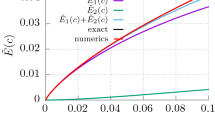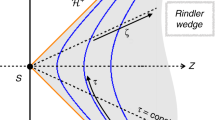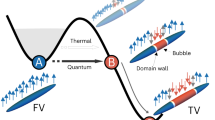Abstract
In spontaneously broken gauge theories of particle interactions there are sometimes several local minima of the effective potential. Any of these minima can serve as a vacuum in the sense that we can expand the fields around their values at the minimum, interpret the quantized fluctuations around the minimum as particles, and compare the properties of these particles with experiment. One might think that only the state with absolutely minimum energy could be what we ordinarily call our vacuum, as the other local minima will inevitably decay into this lowest one. However, this is not necessarily the case, because it is possible for the lifetime of a metastable vacuum to be very long, even when compared with the age of the Universe. Furthermore, the energy densities available in present laboratory or astrophysical environments are much less than the barriers which exist in field space between the different local minima, and so we have no direct sensitivity to the presence of a possibly lower vacuum state. (A possible exception to this are magnetic monopoles which do probe the large field region.) If it is not the absolute minimization of the effective potential, what does determine the present vacuum state of the Universe? We argue here that it is determined cosmologically by the dynamical evolution of the Universe from the hot, dense phase which existed shortly after the big bang to the present1,2.
This is a preview of subscription content, access via your institution
Access options
Subscribe to this journal
Receive 51 print issues and online access
$199.00 per year
only $3.90 per issue
Buy this article
- Purchase on Springer Link
- Instant access to full article PDF
Prices may be subject to local taxes which are calculated during checkout
Similar content being viewed by others
References
Linde, A. D. Phys. Lett. 70B, 306 (1977).
Srednicki, M. Preprint (Princeton University, 1982).
Kirzhnits, D. A. & Linde, A. D. Phys. Lett. 42B, 471 (1972).
Dolan, L. & Jackiw, R. Phys. Rev. D9, 3320 (1974).
Weinberg, S. Phys. Rev. D9, 3357 (1974).
Coleman, S. Phys. Rev. D15, 2929 (1977).
Georgi, H. & Glashow, S. L. Phys. Rev. Lett. 32, 438 (1974).
Buras, A. J., Ellis, J., Gaillard, M. K. & Nanopoulos, D. V. Nucl. Phys. B135, 66 (1978).
Magg, M. & Shafi, Q. Z. Phys. C4, 63 (1980).
Sherry, T. N. J. Phys. A13, 2205 (1980).
Author information
Authors and Affiliations
Rights and permissions
About this article
Cite this article
Turner, M., Wilczek, F. Is our vacuum metastable?. Nature 298, 633–634 (1982). https://doi.org/10.1038/298633a0
Received:
Accepted:
Issue Date:
DOI: https://doi.org/10.1038/298633a0
This article is cited by
-
Bubble evolution around heterogeneities in ϕ4-field theories
Journal of High Energy Physics (2021)
-
Solitons and Instantons in Vacuum Stability: Physical Phenomena
Brazilian Journal of Physics (2020)
-
Catalytic creation of baby bubble universe with small positive cosmological constant
Journal of High Energy Physics (2019)
-
Higgs stability-bound and fermionic dark matter
Journal of High Energy Physics (2019)
-
Impact of new physics on the EW vacuum stability in a curved spacetime background
Journal of High Energy Physics (2017)
Comments
By submitting a comment you agree to abide by our Terms and Community Guidelines. If you find something abusive or that does not comply with our terms or guidelines please flag it as inappropriate.



